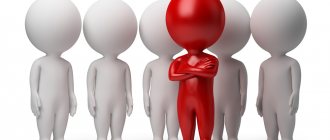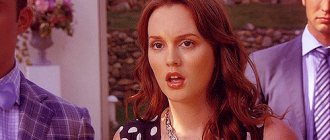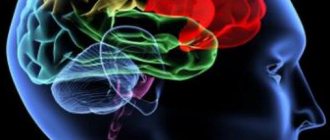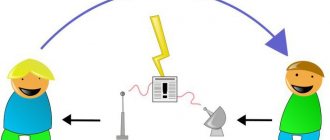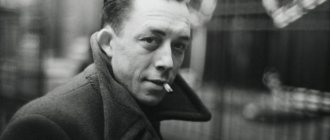What is the value of a person of this type?
The people in question are like tireless motors. Without them, all life would probably stop developing and freeze. At the very least, it would be unbearably boring. And all because it is the individuals of the creative organization who are the initiators of important innovations, the creators of masterpieces of art and the authors of many useful ideas. It must be said that there is simply no single portrait of a person of the named type. However, everyone who claims such a wonderful role has some similar features that set them apart from the crowd.
Individual and personality: differences
A person is born an individual, the status of the individual is already established in the process of development. Distinguishing between the definition of an individual and a personality will help to assess the functioning of a person.
So, what is the difference between an individual and a personality?
- Interaction with society. A person remains an individual from birth to death, and he is formed as a personality only in interaction or opposition with society.
- Confession. All people have equal rights, that is, each person initially has his own individuality. However, personality has certain social advantages: recognition, power, authority.
- Adequacy. One is born an individual, but one becomes a person.
- Mindfulness. The path to acquiring personality status is a conscious action of the individual.
- Quantity. There are tens of millions of personalities in the world, and approximately seven billion individuals.
A person who is removed from society very quickly loses his personality traits - he begins to poorly understand other people, to the point of forgetting the language. At the same time, the development of the genetic code occurs by nature, regardless of the life changes of a person. A person can become an individual even with limited abilities.
But the term individuality is more difficult to define, since in addition to personal properties it includes the physiological and biological qualities of a person.
Individuality is a specific person who has a special combination, distinctive from other individuals, of social, physiological and mental characteristics. Their difference is manifested in human communication, actions and activity.
There have been cases in history when a person lived and was raised among animals. Such people lost their social foundation - the ability to express themselves clearly, and lost their mental abilities. Returning back to human society, they could no longer take root in it. Such cases once again prove that a person who has only a biological beginning cannot become a full-fledged individual.
The transformation of a biological individual into a full-fledged personality is facilitated by labor activity. By doing something important to society, a person can prove his uniqueness.
Comparison
The first thing that any person of this type possesses is a living mind, from which nothing escapes. A creative person lets this life pass through himself and explores it. He sees large details and notices little things. The brain is constantly thinking about something. Sometimes such an interlocutor may not seem very attentive, but perhaps at that very moment another insight came to him.
Creative people have great imagination. They are great dreamers and improvisers. Coming up with something on the fly is common. Moreover, the idea may seem impracticable to others, but the author is firmly convinced that everything is doable, and really achieves success. These are people who are very persistent and strong in spirit. Some people are stupefied and broken by failures. But a creative person views them as a chance to once again demonstrate his wonderful abilities. He rolls up his sleeves and takes decisive action.
How does a creative person differ from others who are not particularly outstanding? Because he is able to turn an ordinary situation into an interesting one that will be remembered for a long time by all its participants. These types of people are passionate about making a statement and they actually have something to say! No, they are not eager to be always visible. On the contrary, sometimes such individuals even become somewhat distant from others. But if they show themselves in something, sometimes it is simply impossible to forget it. At the moment of their creativity, such people are incredibly happy, and this magical energy is transmitted to everyone who comes into contact with the miracle taking place.
Creative individuals are very dedicated to their pursuits. They are able to refuse an unloved job imposed on them by someone and go their own, often very thorny, path. By choosing something interesting for themselves, such people turn work into a process that brings joy. At the same time, they often work spontaneously, trying not to miss the inspiration that comes.
I must say that when creating something, people of this type show incredible persistence. A small detail can take a significant amount of time, but creators do not rest until they achieve the desired result. True, often they are still not completely satisfied with their brainchild and are even afraid to look at it again, lest they discover some flaw that can no longer be corrected.
What is the difference between a creative person and others? The fact is that he does not waste time in this life and only strengthens his individuality. This is the secret of his charm and charisma. But most importantly, each of us is endowed with the ability to create from birth. You just need to listen carefully to yourself to give your talents the opportunity to shine through.
What is the difference between a creative person and a non-creative person - 18 signs
Neuroscience paints a complex picture of creativity. Scientists now understand that the nature of creativity is much more complex than differences in the right- or left-sided orientation of the brain (left hemisphere = rational and analytical, right = creative and emotional). In fact, creativity is believed to involve a number of cognitive processes, neural impulses, and emotions, and we still don't have a complete understanding of how the creative mind works.
From a psychological point of view, creative personality types are difficult to define. They are complex, paradoxical and tend to avoid routine. And this is not just a “tortured artist” stereotype. Research has shown that creativity involves the interaction of many personality traits, behaviors and social influences in one person.
“Creative people actually have a harder time getting to know themselves because they are more complex than non-creative people,” Scott Barry Kaufman, a psychologist at New York University who has spent years researching creativity, told the Huffington Post. “The most paradoxical thing about a creative person... these people have a more chaotic mind.”
There is no “typical” portrait of a creative person, but there are characteristic features in the behavior of creative people. Here are 18 points that are characteristic of them.
They are dreaming
Creative people are dreamers, even though their school teachers may have told you that daydreaming is a waste of time. Kaufman and psychologist Rebecca L. McMillan, who co-authored a paper called “An Ode to Positive Creative Daydreaming,” believe that mind wandering can help with the process of “creative incubation.” And, of course, many know from experience that the best ideas come to us when we are mentally in a completely different place.
Neuroscientists have discovered that imagination involves the same brain processes associated with fantasy and creativity.
They notice everything
A creative person sees opportunities everywhere and constantly absorbs information, which becomes food for creative self-expression. As Henry James is often quoted, a writer is one from whom “nothing escapes.”
Joan Didion always carried a notebook with her and said that she wrote down observations about people and events that ultimately helped her better understand the complexities and contradictions of her own mind.
They have their own opening hours
Many great masters admit that they create their best works either very early in the morning or late in the evening. Vladimir Nabokov began writing as soon as he woke up at 6 or 7 am, and Frank Lloyd Wright made it a habit to wake up at 3 or 4 am and work for several hours before going back to bed. People with high creative potential do not adhere to a standard daily routine.
They find time for privacy
“To be open to creativity, you need to have the ability to use solitude constructively. We must overcome the fear of loneliness,” wrote American existential psychologist Rollo May.
Artists and creatives are often stereotyped as loners, when in fact they may not be. Solitude can be the key to creating your best work. Kaufman links this to imagination—we must give ourselves time to simply dream.
“You need to get in touch with your inner voice to be able to express yourself. It’s hard to hear your inner creative voice if you’re not… in touch with yourself and reflecting on yourself,” he says.
They “digest” life’s obstacles
Many of the most iconic stories and songs of all time were created out of heartbreaking pain. Problems often became the catalyst for the creation of outstanding works. In psychology, this is called post-traumatic growth, which suggests that people are able to use their hardships and early life traumas for significant creative growth. Researchers have found that trauma can help a person succeed in interpersonal relationships, life satisfaction, increased spirituality, personal strength, and the discovery of new possibilities.
They are looking for new experiences
Creative people love to experience new impressions, sensations and states of mind, and this is an important predetermining factor for creative results.
“Openness to new experiences is the strongest predictor of creative achievement,” says Kaufman. “There are many different interconnected aspects here: intellectual curiosity, sensation seeking, openness to emotion and imagination. And all together is the engine for knowledge and exploration of the world, both internal and external.”
They fail
Resilience is almost a necessary quality for creative success, says Kaufman. Failure often befalls a creative person at least a few times, but creatives—at least successful ones—learn not to be sad about it.
“Creative people fail, and truly good people fail often,” Steven Kotler wrote in Forbes in a passage about Einstein’s creative genius.
They ask important questions
Creative people are insatiably curious. They tend to prefer to explore life and even as they mature, they retain the interest of a discoverer. Through active conversations or individual mental reflection, creatives constantly ask themselves a lot of questions as they look at the world.
They watch people
Natural observation and interest in other people's lives sometimes helps generate the best ideas.
“Marcel Proust spent almost his entire life observing people, he wrote down his observations, and this found its way into his books,” says Kaufman. “For many writers, observing people is very important...”
They take risks
Part of being creative requires taking risks, and many successful creatives take risks in various aspects of their lives.
“There is a deep and meaningful connection between risk-taking and creativity that is often overlooked,” writes Steven Kotler in Forbes. “Creativity is the act of creating something out of nothing. It requires the publication of what at first existed only in the imagination. This activity is not for the timid. Wasted time, tarnished reputation, wasted money… These are all side effects when creativity goes awry.”
They see everything in life as an opportunity for self-expression.
Nietzsche believed that life and the world should be viewed as a work of art. Creative individuals are constantly looking for opportunities to express themselves in everyday life.
“Creative expression is self-expression. Creativity is nothing more than a private expression of your needs, desires and uniqueness,” says Kaufman.
They follow their true passion
Creative people tend to be intrinsically motivated. This means that they act based on some internal desire, rather than a desire for external reward or recognition.
Psychologists say that creative people are stimulated by exciting activities, which is a sign of intrinsic motivation. Research shows that simply thinking about your own reasons for doing something can be stimulating enough to boost creativity.
They go beyond their own minds
Kaufman argues that the ability to dream is still necessary to help us move beyond our usual vision and explore other ways of thinking that can be an important asset for creativity.
“Reverie evolves to allow us to let go of the present,” says Kaufman. “The brain network associated with daydreaming is the brain network associated with theory of mind. I like to call it the “imagination network”—it allows you to imagine yourself in the future, but also to imagine the thoughts of others.”
They lose track of time
Creative individuals may find that when they write, dance, paint, or otherwise express themselves, they find themselves in a “state of flow” that helps them create at the highest level. It is a mental state where a person goes beyond conscious thought to achieve a state of heightened concentration and calm. Then he is practically not exposed to either internal or external stimuli that can interfere with his activities.
You find yourself in a “state of flow” when you do something that you really enjoy and that makes you feel good.
They surround themselves with beauty
Creators, as a rule, have excellent taste and love to be in beautiful surroundings.
A study recently published in the journal Psychology of Aesthetics, Creativity, and the Arts found that musicians, including music teachers and soloists, demonstrate high sensitivity and receptiveness to artistic beauty.
They connect the dots
If there's one difference between extremely creative people and everyone else, it's the ability to see opportunities where others don't. Many great artists and writers say that creativity is simply the ability to connect dots that others would never think of connecting.
Steve Jobs said that creativity is bringing things together. When you ask creative people how they did it, they feel a little awkward because they didn't actually do it, they just saw something, connected it to their experience and synthesized new things.
They're constantly shaking
Diversity of experience, more than anything else, is critical to creativity, says Kaufman. Creatives shake things up, try new things, and avoid anything that makes life monotonous or routine.
“Creative people have more varied experiences,” says the psychologist.
They make time for mindfulness and meditation
Creative people understand the value of a clear and focused mind because their work depends on it. Many artists, entrepreneurs, writers and other creative people have used meditation as a tool to tune into the most creative state of mind.
A 2012 Dutch study found that certain meditation techniques actually promote creative thinking. Mindfulness has been linked to improved memory and attention, optimized emotional well-being, reduced stress and anxiety, and improved mental clarity—all of which can lead to more creative thinking.
March 20, 2014
Poor performance by President Macron in Lebanon
Geopolitics
Even today, the human brain is not able to calculate the consequences of the introduction of AI for humanity. Is it possible to let the genie out of the bottle in such a situation? Maybe a person should start restoring his own intelligence, rather than trying to replace it with an artificial one? Similar questions began to arise for some people long before computers, the Internet, neural networks and other attributes of the digital world appeared.
I would especially like to draw attention to the Czech writer Karel Capek (1890-1938). He deserves to be named among the ten most outstanding writers of the twentieth century. I will focus on his play “RUR”, written a hundred years ago, in 1920. By the way, this is not only the date of the creation of a famous literary work, but also the birth of the term “robot”. The abbreviation RUR stands for Rossum's Universal Robots.
The play takes place in a factory that produces artificial people - robots. The word “robot” comes from the Slovak language: robota means “hard labor”, “hard work”, “corvee”. The robots in Capek's play are a product of biotechnology; they are made up of various tissues and organs grown in a factory. They look like people.
The history of robots begins with the scientist Rossum Sr., who once set out to disprove the existence of God by creating artificial people. And he managed to create an artificial man, but not completely. It was a creature that was physically almost indistinguishable from a human, but mentally very retarded. A lonely old man tried to argue with God, but the argument ended with the death of the rebel. Rossum Jr. (nephew of Rossum Sr.) continued his uncle’s work, discarding high philosophy:
“It’s stupid to make a person last ten years. If you don’t produce them faster than nature, your whole shop should go to hell.”
The nephew began to produce simple humanoid creatures in the factory for physical work - not people, but “labor power”. Fortunately, the demand for such labor, devoid of high intelligence, desires, and feelings, was high in the market.
As a result, man was freed from hard, humiliating labor, the massive use of robots created a world of abundance, and everyone was immersed in an atmosphere of boundless prosperity and carefreeness:
“It’s all just a crazy, bestial orgy. Now he won’t stretch out his hands for food - they put it directly in their mouth so that they don’t get up... We, people, we, the crown of creation, we do not grow old from work, we do not grow old from childbearing, we do not grow old from poverty! Quickly, quickly, give us all the pleasures of the world!”
Stuffed people stopped being born. The population on the planet reached 8.5 billion people and froze at this point. And the number of robots continued to grow and many times exceeded the number of people.
At the same time, another mysterious and alarming phenomenon arose. Some robots underwent mutations, beginning rapid mental development. Robots “with soul” have appeared:
“For every million good old robots, there is only one reformed one.”
Such non-standard individuals were subject to destruction, but some of the “advanced” robots continued to live. These were self-learning robots. They learned by following people's example. One of them (named Damon) argues:
“You have to dominate and kill to be human!”
Robots increasingly began to demand equal rights with humans, and some wanted to rule over people. They began to create their own organizations and call on robots to fight humans:
“Robots all over the world! We, the first organization of the Rossum Universal Robots, declare man the enemy of nature(!) and outlaw him!”
It ended with robots all over the world rebelling. They besiege Rossum's factory, take it over and kill everyone except the architect Ahlquist. One of the main characters of the play, Elena Glory, burns the manuscripts of Rossum Sr., containing the formula for producing robots.
What characterizes a person as a person
The word “personality” itself had a negative connotation, since since ancient times it has meant a mask under which a person’s true face is hidden.
Typically, the word “mask” was used to characterize a person’s social image, and most often it was used as an insult.
But a lot of time has passed, and now the word “personality” is widely used both in everyday life of ordinary citizens and in educational literature.
Manifestations of personality can be both permanent and temporary: at one moment a person can show willpower, and in another situation he can simply remain silent.
This topic is studied at school in the 6th grade, in a social studies lesson, and already in the 8th grade this topic is fully covered.
Human
The philosophical concept of "man" includes the fact that he is not an animal. Therefore, questions are even proposed in which you need to find something common between humans and animals and something different.
A person is a biosocial being, a representative of the human race Homo Sapiens, endowed with reason, consciousness, the ability to speak, upright walking, that is, qualities that distinguish him from an animal.
The biological essence of a person is inherited from birth, and the social essence can only be formed in society, through interaction with other people.
§ 3. Society as a form of human life
Question 1. How does history explain the origins of man and society?
In our country, three hypotheses of the origin of society are usually noted:
• natural (“labor created man” and turned the herd into a cultural community of producers),
• divine (“God created man” and commanded him the material world and the moral law),
• cosmic (“aliens created people” and manipulate human progress for their laboratory purposes).
Question 2. Can a person live outside of society? Is society simply the sum of living people? Does the fate of a person depend on the fate of society?
No, a person cannot exist normally outside of society. Man is a social being. The development of a person completely depends on society, just as the development of society depends on a person, because society is all of us together, it consists of individuals. Outside society, only degradation is possible. In life, we all develop qualities and talents, and this shapes our consciousness and intellect. And this can only be done in society. Any self-centered desires for privacy will not bring anything good.
Society in a broad sense is a form of association of people who have common interests, values and goals. Human societies are characterized by a pattern of relations (social relations) between people, which can be described as the totality of such relations between its subjects.
The fate of a person, of course, depends on the fate of society. But this dependence is determined by the person himself. There are only a few people who think outside the categories of society. We are products of the social system. Since childhood, our consciousness has been sharpened for certain social forms. Plus, people by their nature are social creatures and the herd instinct forces them to stick together, do like everyone else, want what everyone else wants.
Question 3. What is the meaning of the scientific concept of “society”?
Society in a broad sense is a form of association of people who have common interests, values and goals. Human societies are characterized by a pattern of relations (social relations) between people, which can be described as the totality of such relations between its subjects. In the social sciences, society as a whole often exhibits stratification.
Question 4. What are social relations?
Social relations are various social relationships that arise in social interaction, related to the position of people and the functions they perform in society.
Social relations are a set of socially significant connections between members of society.
Social relations (social relations) - the relations of people to each other, consist of historically defined social forms, in specific conditions of place and time. Social relations (social relations) - relations between social subjects regarding their equality and social justice in the distribution of life's goods, conditions for the formation and development of personality, satisfaction of material, social and spiritual needs. Social relations are those relationships that are established between large groups of people. Beyond the sphere of manifestation, social relations can be divided into: economic, political, spiritual, social.
Question 5. What spheres of people’s life does society include?
Society can be divided into four areas, or spheres. They make it possible to identify its parts in a whole society, each of which includes elements and relationships, united according to their place and role in the life of society.
The economic sphere is largely decisive in relation to other spheres. It includes industrial and agricultural production, transport, and the service sector. This sphere covers economic relations that mediate production, distribution, exchange, and consumption.
The social sphere includes layers and classes, class relations, nations and national relations, family, family and household relations, educational institutions, medical care, and leisure.
The political sphere of social life includes state power, political parties, and people’s relationships associated with the use of power to realize the interests of certain social groups.
The spiritual sphere covers science, morality, religion, art, scientific institutions, religious organizations, cultural institutions, and related human activities.
All four spheres interact with each other.
Question 6. How do social norms in the form of permission, prescription and prohibition differ from each other?
An order is the imposition by the relevant norm of law of a direct legal obligation to perform one or another legally significant action under the conditions provided for by this norm. Consequently, the norm indicates that one must act in the appropriate conditions exactly this way and not otherwise. For example, it has been established that public associations, in order to obtain the status of a legal entity (in the civil legal sense), must undergo state registration with the authorized executive authorities; citizens who have reached the age of 14 must obtain a passport, etc.
A ban is actually also an order, but of a different legal content. Its meaning is that a rule of law imposes on its addressees a direct legal obligation to refrain from committing certain legally significant actions under the conditions provided for by this rule. For example, police officers are prohibited from using weapons against women, persons with obvious signs of disability, as well as in large crowds of people, for example, to free hostages, etc.
Permission is a legal permission to perform certain legally significant actions under the conditions provided for by this norm, or to refrain from performing them at one’s own discretion.
Question 7. What role do social norms play in the life of a person and society?
Social norms—rules of behavior that were developed in accordance with the needs of society—are aimed at preserving the integrity of society and regulating various relationships between people.
Social norms show what behavior society approves of and what it does not approve of. Customs are among the oldest social norms. Customs of hospitality, respect for elders, etc. are widespread.
Question 8. How did people’s lives change during the transition from one stage of social development to another?
Society has come a long way, on which science identifies several stages. If we consider first of all the means by which people produce the material goods they need, as well as the experience accumulated in such production, then we can see three stages in the development of society.
The first stage - traditional (agrarian) society - is characterized by the dominance of rural subsistence farming, class hierarchy, the decisive role in the life of society belongs to the guardians of the cult - priests or the church and the army. In these societies cities, crafts, trade, money, and writing appeared. But the family remains the main production unit, communal principles, traditions and customs prevail. The bulk of the population lives in villages.
At the next stage - in industrial society - significant changes occur.
Scientists point out the following differences between an industrial society and an agricultural one:
— not agricultural, but industrial production predominates;
the decisive role in social life belongs not to small and large landowners, but to industrialists and businessmen;
— at the center of social organization are not the church and the army, but corporations (associations of individuals with common commercial interests).
This society is based on the development of large-scale machine production, and is characterized by the use of scientific achievements as the main factor of production.
The entire way of life of society is changing: agriculture, transport, communications, professional skills, education, human culture. The share of the population employed in agriculture is decreasing, while the urban population is growing.
It is believed that modern Russia is also an industrial society. The most economically developed countries of the world (USA, Japan, etc.), according to many scientists, are moving to the third stage of development - entering a post-industrial (information) society. Of particular importance here is not the quantity of labor expended, but its quality and, consequently, the qualifications, creativity, and personal qualities of the people involved in production. Experts consider scientific and technological progress and information technology to be the main factor of production in such a society. Computer processing of information and its transmission over any distance in the shortest possible time are becoming widespread. In a post-industrial society, the production of scientific knowledge, scientific research and development, based on university (comprehensive) education, become leading. Knowledge (information) turns into the most important factor in people’s life. In the economy, the service sector begins to dominate over the production of goods.
Question 9. How do you feel about the statement: “The emergence of man and the emergence of society are processes inextricably linked with each other”? Give arguments that confirm or refute this idea.
Man is a biosocial being that cannot exist outside of society. People have always strived to unite in communities to engage in any activity.
Question 10. In your history course you studied slave and feudal societies. What are the main differences between them in each of the four spheres of society discussed in this paragraph?
1. slaves did not have their own farm, their own means of production, but serfs in feudal society did, although very limitedly;
2. slaves could not have their own families, but serfs could start a family (get married);
3. the slave was the full property of the slave owner, and the serf was also the property of the feudal lord, but had some freedom;
4. the slave was not interested in the results of his labor (they still don’t pay him, they can do whatever they want with him and even kill him), and the serf peasant, on the contrary, was interested (although the feudal lord appropriated a large share of his labor).
But a society of a feudal formation cannot be called only a class of serfs; in such a society there could also be free peasants, but there were few of them, since the land in their possession was small (in size), and as is known, the land provided the main income for such peasants.
Question 11. Express your opinion on the following statement: “It is impossible to live in society and be free from society.” Think about whether a person can become free if he lives outside of society.
Perhaps a person would be free without society, but in the 21st century society is everywhere. And not everyone could survive alone. How to survive alone? This is impossible. A man without people is not a man. There is no such thing as absolute freedom. There is no escape from society.
Question 12. Argue your position in relation to the following statement of the Russian publicist and literary critic V. G. Belinsky: “A living person carries the life of society in his spirit, in his heart, in his blood: he suffers from its ailments, suffers from its sufferings, blooms his health, blissful with his happiness, outside of his own, his own personal circumstances.”
A person is not an egoist and lives not only with his own problems and his own happiness, but also with the problems and joys of those around him.


